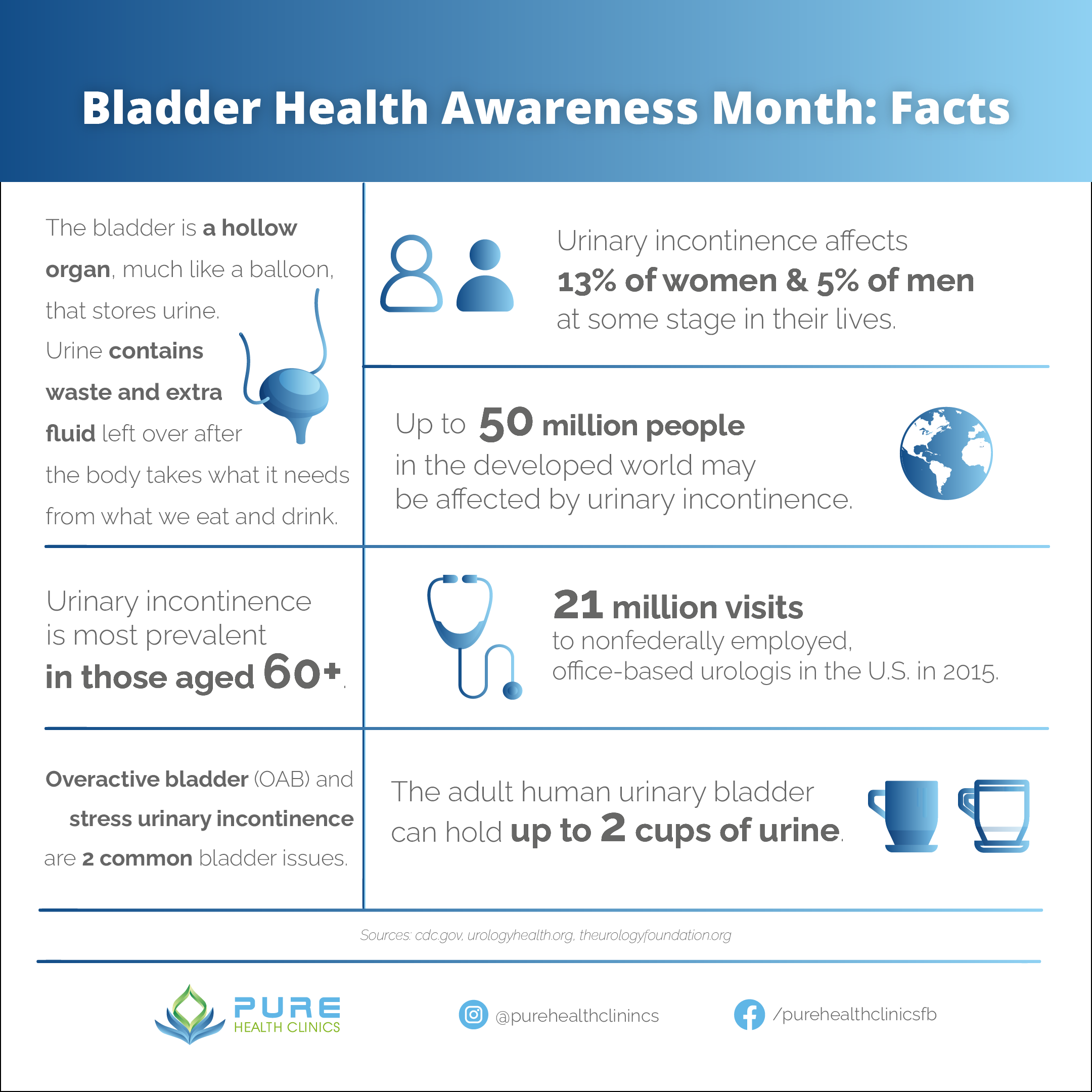At Pure Health Clinics we are proud to join Bladder Health Awareness Month, an initiative brought forth by the Urology Care Foundation. During November, we encourage the audience to learn more about bladder health and destigmatize bladder-related issues. Read along to find key bladder facts, tips on how to maintain bladder health, and tools to deal with any potential threats.
Bladder Health
The bladder is a hollow organ in the human body located in the pelvis that stores urine. It has a capacity of approximately 400 cc (and up to 500 cc.). And once it is full, it disposes of the urine by urination. In this bladder health awareness month, we want to focus on how important it is to keep the bladder healthy, just as you would do with any other organ. For example, to protect your skin (the largest organ) from sun damage, you wear sunscreen; therefore here are some facts to get to know your bladder better and some tips to keep it in tip-top shape.
Bladder Facts
- The tube through which the urine leaves the bladder is called the urethra. Women’s urethras are shorter than men’s.
- Additionally, people with shorter urethras are more prone to contracting UTIs.
- The kidneys balance many chemical levels in the body (sodium, potassium, calcium, phosphorus and others) and check the acidity in the blood.
- About 13 million Americans suffer from urinary incontinence.
- UTI symptoms might be overlooked. In the elderly segment, especially, it is easy that some symptoms go unnoticed.
- Stress incontinence affects up to 35% of adult women, due to a variety of causes. This is a condition that provokes urine leaks when sneezing, coughing, or laughing, for example.
- Bladder cancer is the sixth most common type of cancer. It develops in the tissue of the bladder

Tips on How to Maintain Bladder Health
🩺 Urinary Tract Infections and incontinence, along with other bladder issues, can be prevented or improved by following these recommendations:
- Drink plenty of water. You might have heard this one, and it’s because it is oh-so effective. Aim to go up to 8 cups a day and, at the same time, cut down on the alcohol and caffeine intake.
- In the case of women, we advise them to sit on the toilet rather than hovering over the seat.
- Also, it is very important to take your time while in the bathroom. This is because you should give your bladder time to empty.
- Lastly, women should wipe from the front to the back to keep bacteria off the urethra.
- Exercise! Your pelvis has muscles that you can strengthen by doing some pelvic exercises.
- It is also very important to urinate after sexual activity, as it can move bacteria to the urethral opening.
- Wear cotton underwear. This keeps the urethra dry and lowers the chances of developing fungi.
- Finally, speak up. If you are having bladder health issues, do not hesitate to contact your doctor and talk about it.
Some Signs of Bladder Issues
- Incontinence, i.e., not being able to hold urine in certain (or many) situations.
- Tainted urine
- Pain or burning sensation when urinating or after
- A frequent need to urinate (more than 6 or 8 times per day)
- Bloody urine
➡ Learn more about incontinence and what you can do about it here.
Incontinence and Bladder Health
Urinary incontinence happens when we can’t control the leaking of urine. Unfortunately, this problem brings with it psychological issues due to the stigmatization that people may face. On top of that, it also affects social life.
How does the urinary system work? Urination is controlled by the bladder and the brain, with a little help from the pelvic muscles. The bladder stores urine excreted by the kidneys and when it’s full, it sends a signal to the brain and urine comes out of the urethra. The pelvic muscles are the ones that help keep the bladder in place and the urine in. When the sphincter muscles keep the urethra closed, there is no leak.
There are different types of urinary incontinence:
- Stress Urinary Incontinence (SUI). This happens when the pelvic muscles can’t stop urine from leaking when the body is under stress.
- Overactive Bladder (OAB). Having an OAB means that people need to empty their bladders more than the average 6-8 times a day.
- Mixed Incontinence (SUI & OAB).
- Overflow Incontinence. As the name indicates, this happens when the body produces more urine than the bladder can hold, and therefore starts leaking.
EMSELLA: a Breakthrough Treatment for Incontinence
During this Bladder Health Awareness Month, at Pure Health Clinics we want to take the opportunity to share a breakthrough, non-invasive treatment for both men and women who suffer from urinary incontinence, EMSELLA. This method aims at strengthening the pelvic floor muscles, including those that cannot be exercised with kegels.
EMSELLA is a chair where you can sit comfortably and receive supramaximal muscle contractions. This way, the muscles are reeducated and patients can recover and regain control over their bladder.
➡ Related: Does Emsella Help with Urinary Urgency?
Urological Care at Pure Health
Our state-of-the-art facilities and experienced, award-winning medical staff guarantee first-rate medical services. At Pure Health, our exceptional health providers offer personalized plans for each patient and follow their journey to healing from beginning to end. When it comes to bladder health and incontinence in Houston and the North West, we provide world-class care. Schedule your appointment today to access a superior experience.


